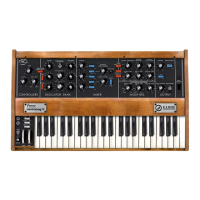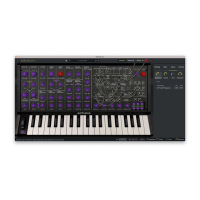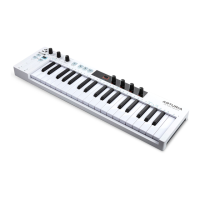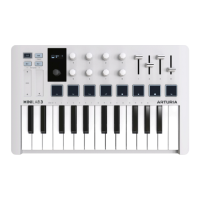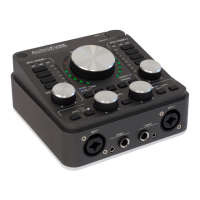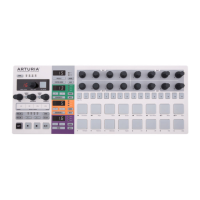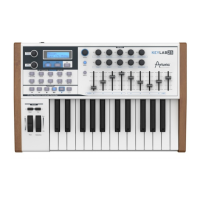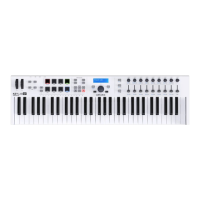Do you have a question about the Arturia VOCODER V and is the answer not in the manual?
Notes that manual information is subject to change without prior notice.
Warns about potential hearing damage from high sound levels.
Discusses the vocoder's history, musical impact, and modern capabilities.
Explains the fundamental principles of vocoder operation, including modulator and carrier signals.
Lists the minimum computer specifications required for running Vocoder V.
Details the process of activating the software license using the Arturia Software Center.
Covers configuring audio and MIDI settings for standalone operation.
Explains compatibility and behavior when used within a Digital Audio Workstation (DAW).
Introduces the main functional areas: Voice, Modulations, and Effects.
Describes the built-in synthesizer that generates the carrier signal.
Details the core vocoding engine and its controls.
Provides a general layout of the main interface sections: Toolbars and Panels.
Covers file management, preset browsing, and access to advanced features.
Offers quick access to important parameters and status indicators like CPU usage.
Manages MIDI controller configuration, macros, and tutorials.
Explains how to search, audition, and manage presets and playlists.
Introduces the purpose of the Voice page for modulation sources.
Details how to route external audio signals for modulation.
Covers loading, playback modes, and editing of stored audio samples.
Explains the keyboard interface for playing notes and triggering samples.
Details the Voltage Controlled Oscillators that generate the sound.
Covers parameters like Bend Range, Glide, Hold, and Chord selection.
Manages modulator and carrier input levels and monitoring.
Adjusts modulator envelope response and vocoder timbre.
Adjusts high-frequency content for intelligibility and balances noise/buzz.
Covers Patch Bay for routing and Sample and Hold modulation.
Introduces the concept of modulation for adding sonic variety and expressiveness.
Generates a modulation signal based on input signal amplitude using Gain, Rise, and Fall controls.
Provides a Low-Frequency Oscillator with various waveforms for periodic modulation.
Allows routing modulation sources to various destinations using six slots.
Lists and briefly describes the 11 high-quality built-in effects.
Shows the interface for accessing and managing the three effect slots.
Configures effects in series or parallel connections using routing options.
Details the universal controls available for each effect slot, like type selection and Dry/Wet.
Provides in-depth explanations of each effect's parameters and function, from Reverb to Stereo Pan.
Outlines Arturia's ownership, user rights, and software activation process.
Details provisions for support, upgrades, warranty terms, and liability.
Notes that manual information is subject to change without prior notice.
Warns about potential hearing damage from high sound levels.
Discusses the vocoder's history, musical impact, and modern capabilities.
Explains the fundamental principles of vocoder operation, including modulator and carrier signals.
Lists the minimum computer specifications required for running Vocoder V.
Details the process of activating the software license using the Arturia Software Center.
Covers configuring audio and MIDI settings for standalone operation.
Explains compatibility and behavior when used within a Digital Audio Workstation (DAW).
Introduces the main functional areas: Voice, Modulations, and Effects.
Describes the built-in synthesizer that generates the carrier signal.
Details the core vocoding engine and its controls.
Provides a general layout of the main interface sections: Toolbars and Panels.
Covers file management, preset browsing, and access to advanced features.
Offers quick access to important parameters and status indicators like CPU usage.
Manages MIDI controller configuration, macros, and tutorials.
Explains how to search, audition, and manage presets and playlists.
Introduces the purpose of the Voice page for modulation sources.
Details how to route external audio signals for modulation.
Covers loading, playback modes, and editing of stored audio samples.
Explains the keyboard interface for playing notes and triggering samples.
Details the Voltage Controlled Oscillators that generate the sound.
Covers parameters like Bend Range, Glide, Hold, and Chord selection.
Manages modulator and carrier input levels and monitoring.
Adjusts modulator envelope response and vocoder timbre.
Adjusts high-frequency content for intelligibility and balances noise/buzz.
Covers Patch Bay for routing and Sample and Hold modulation.
Introduces the concept of modulation for adding sonic variety and expressiveness.
Generates a modulation signal based on input signal amplitude using Gain, Rise, and Fall controls.
Provides a Low-Frequency Oscillator with various waveforms for periodic modulation.
Allows routing modulation sources to various destinations using six slots.
Lists and briefly describes the 11 high-quality built-in effects.
Shows the interface for accessing and managing the three effect slots.
Configures effects in series or parallel connections using routing options.
Details the universal controls available for each effect slot, like type selection and Dry/Wet.
Provides in-depth explanations of each effect's parameters and function, from Reverb to Stereo Pan.
Outlines Arturia's ownership, user rights, and software activation process.
Details provisions for support, upgrades, warranty terms, and liability.
| Brand | Arturia |
|---|---|
| Model | VOCODER V |
| Category | Recording Equipment |
| Language | English |
